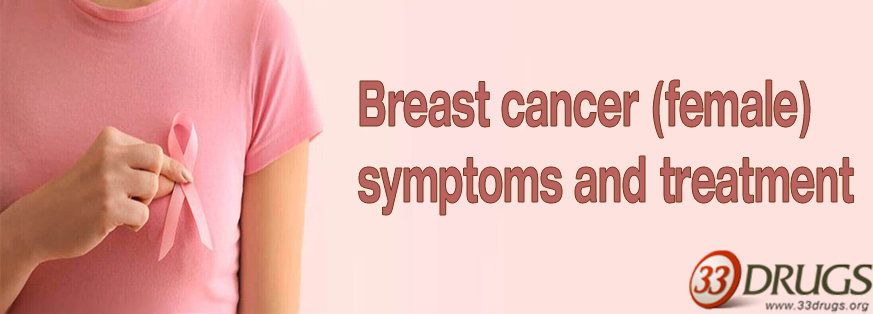Breast cancer is an uncontrolled growth of breast cells. Cancer occurs as a result of mutations, or abnormal changes, in the genes responsible for regulating the growth of cells and keeping them healthy. The genes are in each cell’s nucleus, which acts as the “control room” of each cell. Normally, the cells in our bodies replace themselves through an orderly process of cell growth: healthy new cells take over as old ones die out. But over time, mutations can “turn on” certain genes and “turn off” others in a cell. That changed cell gains the ability to keep dividing without control or order, producing more cells just like it and forming a tumor.
Types of breast cancer
There are several different types of breast cancer, which can develop in different parts of the breast. A tumor can be benign (not dangerous to health) or malignant (has the potential to be dangerous). Benign tumors are not considered cancerous: their cells are close to normal in appearance, they grow slowly, and they do not invade nearby tissues or spread to other parts of the body. Malignant tumors are cancerous. Left unchecked, malignant cells eventually can spread beyond the original tumor to other parts of the body.
The term “breast cancer” refers to a malignant tumor that has developed from cells in the breast. Usually, breast cancer either begins in the cells of the lobules, which are the milk-producing glands, or the ducts, the passages that drain milk from the lobules to the nipple. Less commonly, breast cancer can begin in the stromal tissues, which include the fatty and fibrous connective tissues of the breast.
The exact causes of breast cancer are not fully understood, but many factors increase the likelihood of developing it, including age and family history of breast cancer. Only 5-10% of cancers are due to an abnormality inherited from your mother or father. Instead, 85-90% of breast cancers are due to genetic abnormalities that happen as a result of the aging process and the “wear and tear” of life in general.
There are steps every person can take to help the body stay as healthy as possible, such as eating a balanced diet, maintaining a healthy weight, not smoking, limiting alcohol, and exercising regularly (learn what you can do to manage breast cancer risk factors). While these may have some impact on your risk of getting breast cancer, they cannot eliminate the risk.
What Are the Symptoms of Breast Cancer?
Identifying signs of breast cancer early on can prevent it from spreading to other areas of the body (called metastasis). In its early stages, breast cancer usually has no symptoms. At this time the tumor is just forming and remains largely undetected in the breast. As a tumor develops, you may note the following signs:
- A lump in the breast or underarm that persists after your menstrual cycle. This is often the first apparent symptom of breast cancer. Lumps associated with breast cancer are usually painless, although some may cause a prickly sensation. Lumps are usually visible on a mammogram long before they can be seen or felt.
- Swelling (part or all of the breast, with or without a lump)
- Swelling in an underarm lymph node
- Pain or tenderness in the breast, nipple pain. Although lumps are usually painless, pain or tenderness can be a sign of breast cancer.
- A noticeable flattening or indentation on the breast, which may indicate a tumor that cannot be seen or felt.
- Any change in the size, contour, texture, or temperature of the breast. A reddish, pitted surface like the skin of an orange could be a sign of advanced breast cancer.
- A change in the nipple, such as a nipple retraction, dimpling, itching, a burning sensation, or ulceration. A scaly rash of the nipple is symptomatic of Paget’s disease, which may be associated with an underlying breast cancer.
- Unusual discharge from the nipple that may be clear, bloody, or another color. It’s usually caused by benign conditions but could be due to cancer in some cases.
- A marble-like area under the skin.
- An area that is distinctly different from any other area on either breast.
- vaginal pain
- unintentional weight loss
- visible veins on the breast
- decreased libido
If you experience one or more of these symptoms, make an appointment with your doctor. After an examination, they may feel it necessary to refer you to a specialist breast cancer clinic for further tests.
Treating breast cancer
When deciding what treatment is best for you, your doctors will consider:
- the stage and grade of your cancer (how big it is and how far it has spread)
- your general health
- whether you have been through the menopause
Depending on the type and stage of cancer, treatments can vary. However, there are some common practices doctors and specialists use to combat breast cancer:
- Mastectomy: Surgical removal of part or the whole breast to remove a tumor and connecting tissue
- Lumpectomy: removes the tumor while leaving the breast intact
- Chemotherapy: the most common cancer treatment, chemotherapy uses anticancer drugs to interfere with cells’ ability to reproduce
- Radiation: another standard in the fight against cancer, radiation uses X-rays to directly treat cancer
- Hormone and Targeted Therapy: used when either genes or hormones play a part in the cancer’s growth.
Being diagnosed with breast cancer can affect daily life in many ways. However, there is support available for many aspects of living with breast cancer including emotional, financial and long-term health issues.
One in nine women is affected by breast cancer during their lifetime. There is a good chance of recovery if it is detected in its early stages. For this reason, it is vital that women check their breasts regularly for any changes and always get any changes examined by their doctor.

Leave a Reply